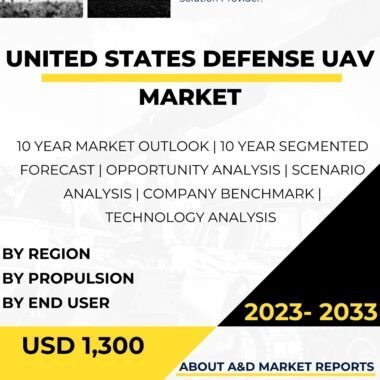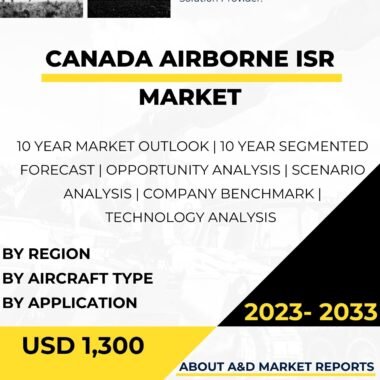Description
The Brazil Airborne Intelligence, Surveillance, and Reconnaissance (ISR) Market is a critical and dynamic sector within the country’s defense industry, focused on enhancing the nation’s military capabilities to gather crucial intelligence, conduct surveillance, and execute reconnaissance missions from the air. As Brazil seeks to bolster its defense readiness and enhance its situational awareness, the demand for advanced airborne ISR systems has grown significantly, positioning the country as a key player in the global Airborne ISR Market.
The Brazil Airborne ISR Market encompasses a wide range of defense applications, each contributing to the country’s overall defense capabilities and strategic decision-making. One of the primary applications is the development and integration of Airborne Early Warning and Control (AEW&C) systems. These systems are equipped with powerful radar and sensor suites mounted on airborne platforms, such as aircraft or unmanned aerial vehicles (UAVs), enabling early detection of aerial threats and providing real-time situational awareness to military commanders. AEW&C systems play a crucial role in detecting hostile aircraft, managing airspace, and facilitating effective air defense operations.
Moreover, the market addresses the role of airborne ISR in maritime surveillance. Maritime patrol aircraft equipped with radar, electro-optical/infrared (EO/IR) sensors, and communication systems are used to monitor maritime activities, detect illegal fishing, track drug trafficking, and protect maritime borders. These airborne ISR platforms enhance Brazil’s maritime security and contribute to the protection of its territorial waters and exclusive economic zones.
The Brazil Airborne ISR Market also focuses on the development of unmanned aerial vehicles (UAVs) for intelligence, surveillance, and reconnaissance missions. UAVs provide the military with a cost-effective and versatile means of gathering intelligence and conducting surveillance in various operational environments, including remote and hostile areas. These UAVs can be equipped with advanced sensors, cameras, and communication systems to collect valuable information and transmit it in real-time to ground stations.
The integration of advanced technologies has been instrumental in the development of airborne ISR systems in Brazil. Research and development efforts focus on improving sensor capabilities, data processing algorithms, and communication systems to enhance the performance of airborne ISR platforms. The development of airborne ISR systems often involves collaboration between the defense industry, research institutions, and the Brazilian Armed Forces, ensuring that the systems meet the stringent requirements of the country’s defense operations.
The export-oriented focus of the Brazil Airborne ISR Market has expanded its global presence. Brazilian airborne ISR technology and defense systems have gained international recognition for their reliability, performance, and cost-effectiveness. Brazil places a high priority on responsible arms trade, ensuring that its airborne ISR exports are subject to robust end-user controls and adhere to international arms transfer agreements.
Brazil’s defense industry actively engages in research and development (R&D) activities to advance airborne ISR systems continuously. Collaboration between the defense industry, research institutions, and the Brazilian Armed Forces fosters innovation and technological advancements in the market. This synergy ensures that airborne ISR systems produced meet the stringent requirements of the country’s military and adhere to the highest quality and safety standards.
Moreover, the market benefits from Brazil’s expertise in avionics, radar technology, and UAV systems. Brazilian companies have been at the forefront of developing state-of-the-art airborne ISR platforms, addressing the unique challenges of providing reliable and effective ISR solutions for various defense applications.
Despite the impressive progress and benefits of airborne ISR systems, challenges remain in the market. One of the primary challenges is the integration of ISR systems with existing military communication and command and control systems. Ensuring seamless interoperability and effective data sharing between airborne ISR platforms and other defense assets is crucial to optimizing the effectiveness of these systems in complex operational environments.
Moreover, the market faces challenges related to the constantly evolving threat landscape. As adversaries develop new and sophisticated technologies to evade detection and surveillance, airborne ISR systems must continually adapt and improve to effectively gather intelligence and maintain situational awareness.
Looking ahead, the future of the Brazil Airborne ISR Market remains promising, driven by continuous research and development efforts, international collaborations, and the increasing demand for advanced intelligence, surveillance, and reconnaissance solutions in modern military operations. As defense and security challenges evolve, Brazil’s dedication to innovation and technological prowess will solidify its position as a leading player in the global Airborne ISR Market. The market’s ability to provide efficient and effective airborne ISR systems while addressing emerging challenges will enhance the nation’s defense readiness, improve situational awareness, and contribute to global security efforts.




